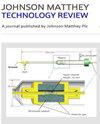Nitrides, Hydrides and Carbides as Alternative Heterogeneous Catalysis for Ammonia Synthesis: A Brief Overview
IF 2
4区 化学
Q4 CHEMISTRY, PHYSICAL
引用次数: 0
Abstract
Driven by the desire to develop novel catalyst formulations which are applicable for localised, more sustainable routes, the area of heterogeneously catalysed ammonia synthesis has attracted much attention in the academic literature in recent times. One of the key incentives for this has been the idea that ammonia synthesis for the production of synthetic fertiliser can be achieved on, for example, a farm close to its point of application with the required hydrogen feedstream being derived from sustainable sources such as electrolysis of water accomplished using electricity produced using wind turbines or solar energy sources. Further drivers are the possible application of ammonia as a non-fossil based fuel and also as a means to indirectly store intermittent over-supply of sustainably derived electricity. In the literature, the energy intensive nature of the Haber Bosch Process, frequently quoted to be 1-2% of global energy demand, and its CO2 footprint, stated to comprise 2.5% of fossil fuel based emissions, are statistics that are frequently quoted in justification for the search for new routes to ammonia production [1,2]. However, due recognition has to be given to the highly efficient integration of the Haber Bosch Process as currently operated. In relation to this, large scale synthesis of ammonia is highly optimised and it can be credited with the sustenance of ca 40% of the global population. These considerations, coupled to the recently reported UK CO2 supply chain shortage, related to a reduction in commercial fertiliser production [3], underline the importance of the highly integrated nature of the process.氮、氢化物和碳化物作为氨合成的多相催化剂:综述
在开发适用于局部、更可持续路线的新型催化剂配方的愿望的推动下,多相催化合成氨领域近年来引起了学术文献的广泛关注。其中一个关键的激励因素是,用于生产合成肥料的氨合成可以在靠近其应用点的农场上实现,例如,所需的氢原料来自可持续来源,例如使用风力涡轮机或太阳能产生的电力完成的水电解。进一步的驱动因素是氨作为非化石燃料的可能应用,以及作为间接储存间歇性供应过剩的可持续衍生电力的手段。在文献中,Haber Bosch工艺的能源密集型性质,经常被引用为占全球能源需求的1-2%,其二氧化碳足迹,据称占化石燃料排放量的2.5%,这些统计数据经常被引用为寻找氨生产新途径的理由[1,2]。然而,必须对目前运作的哈伯-博世工艺的高效整合给予应有的承认。与此相关,氨的大规模合成是高度优化的,它可以被认为是全球约40%人口的食物。这些考虑,再加上最近报道的英国二氧化碳供应链短缺,与商业肥料生产减少有关,强调了该过程高度一体化的重要性。
本文章由计算机程序翻译,如有差异,请以英文原文为准。
求助全文
约1分钟内获得全文
求助全文
来源期刊

Johnson Matthey Technology Review
CHEMISTRY, PHYSICAL-
CiteScore
4.30
自引率
4.30%
发文量
48
审稿时长
12 weeks
期刊介绍:
Johnson Matthey Technology Review publishes articles, reviews and short reports on science enabling cleaner air, good health and efficient use of natural resources. Areas of application and fundamental science will be considered in the fields of:Advanced materials[...]Catalysis[...][...]Characterisation[...]Electrochemistry[...]Emissions control[...]Fine and speciality chemicals[...]Historical[...]Industrial processes[...]Materials and metallurgy[...]Modelling[...]PGM and specialist metallurgy[...]Pharmaceutical and medical science[...]Surface chemistry and coatings[...]Sustainable technologies.
 求助内容:
求助内容: 应助结果提醒方式:
应助结果提醒方式:


